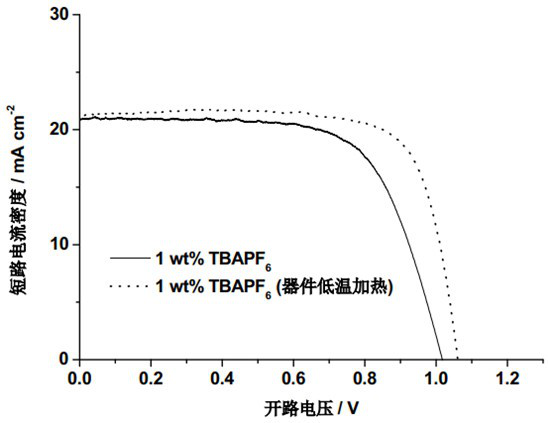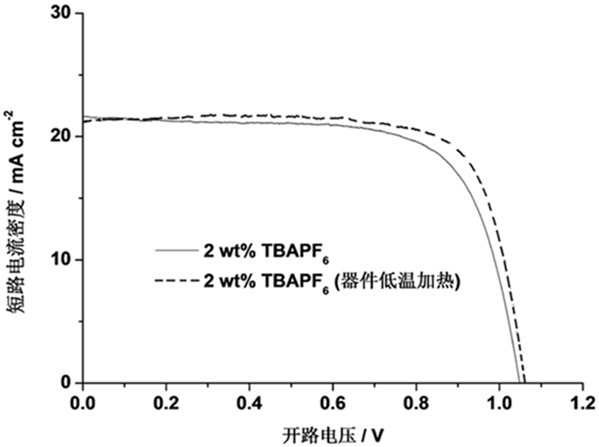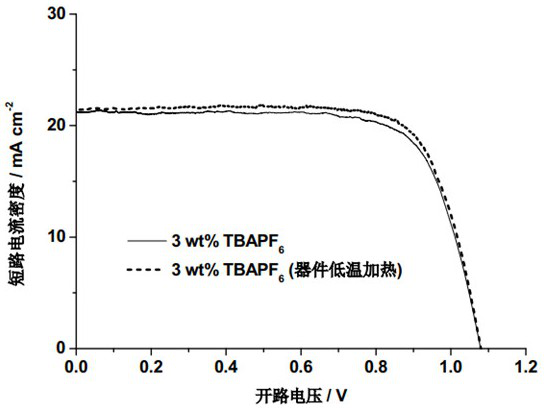A temperature-induced method for deep doping of hole dopants at low concentrations
A technology of temperature induction and dopant, applied in the direction of semiconductor devices, semiconductor/solid-state device manufacturing, electrical components, etc., can solve problems affecting the stability of solar cells, reducing device performance and stability, and affecting device stability, etc., to achieve Effect of inhibiting the formation of perovskite, inhibiting aggregation and crystallization, and improving photovoltaic performance
- Summary
- Abstract
- Description
- Claims
- Application Information
AI Technical Summary
Problems solved by technology
Method used
Image
Examples
Embodiment 1
[0034] Step 1: Clean the surface of FTO conductive glass with detergent, deionized water, acetone and absolute ethanol in sequence, and dry it with nitrogen gas for later use;
[0035] Step 2: Add diisopropyl bis(acetylacetonate) titanate into n-butanol, stir to make it evenly mixed, and obtain mixed solution A;
[0036] Step 3: Spin-coat the mixed solution A on the surface of the FTO conductive glass cleaned in step 1, and bake at 150 °C for 30 min to obtain dense TiO 2 Floor;
[0037] Step 4: Add TiO 2 Add the slurry into absolute ethanol, stir to make it evenly mixed, and obtain the mixed liquid B;
[0038] Step 5: Densified TiO obtained in Step 3 2 Spin-coat the mixed solution B on the surface of the FTO conductive glass layer, bake at 125 °C for 10 min, and anneal at 500 °C for 60 min to obtain mesoporous TiO 2 Floor;
[0039] Step 6: Prepare 1.1 M of FA x MA 1-x PB 3 (x=0.8) solution, where, FA + is CH(NH 2 ) 2 + , MA + is CH 3 NH 3 + , using a mixed solv...
Embodiment 2
[0044] Steps 1-6, Step 8 and Step 9 are the same as in Example 1, the difference is that TBAPF in Step 7 6 The mass concentration is 2 wt%.
Embodiment 3
[0046] Steps 1-6, Step 8 and Step 9 are the same as in Example 1, the difference is that TBAPF in Step 7 6 The mass concentration is 3 wt%.
PUM
 Login to View More
Login to View More Abstract
Description
Claims
Application Information
 Login to View More
Login to View More - R&D
- Intellectual Property
- Life Sciences
- Materials
- Tech Scout
- Unparalleled Data Quality
- Higher Quality Content
- 60% Fewer Hallucinations
Browse by: Latest US Patents, China's latest patents, Technical Efficacy Thesaurus, Application Domain, Technology Topic, Popular Technical Reports.
© 2025 PatSnap. All rights reserved.Legal|Privacy policy|Modern Slavery Act Transparency Statement|Sitemap|About US| Contact US: help@patsnap.com



